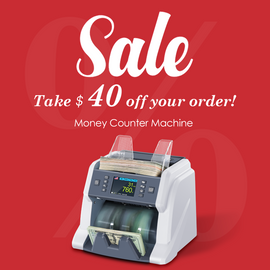Checks are still a vital part of the financial landscape, despite the rise of digital payments. According to the data from the Federal Reserve Board, the average daily volume of government checks processed by the Federal Reserve in 2023 was 0.2 million items, and the average daily value was 0.9 billion dollars. The average value per check was 4,838 dollars. That’s a lot of money moving around!
But how do banks and businesses handle all these checks efficiently and securely? The answer is check scanners – these essential tools help streamline the check processing system, offering numerous benefits along the way. In this article, we’ll explore how check scanners work, the different types available, and the advantages they provide to the banking and financial industries.
Understanding the Check Scanning Process
Check scanners are electronic devices that capture images and extract data from checks, facilitating their digital processing. The scanning process typically involves the following steps:
- Preparation – The check is inserted into the scanner either manually by the operator or automatically via a document feeder. Checks should be properly oriented and free of contaminants like staples to avoid jamming.
- Scanning – The scanner utilizes a Contact Image Sensor (CIS) or Charge Coupled Device (CCD) to digitally capture high resolution images of the front and back of the check. Optical Character Recognition (OCR) technologies are leveraged to enhance image quality.
- Image Processing – Captured images undergo processing to improve clarity, sharpness, orientation and alignment. Thresholding, deskewing and cropping may be applied. Images are compressed for efficient storage and transmission.
- Data Extraction – Intelligent Character Recognition (ICR) and CAR/LAR technologies are used to isolate and extract key data fields from the check image like the routing number, account number, check number and amount.
- Verification – Extracted data undergoes validation checks against standards for routing numbers, account numbers and check amounts. Data is verified against fraud detection algorithms and databases.
- Validation – The check image and extracted data is transmitted to the paying bank over secure networks for further verification, validation and approval. Confirmation of deposit is provided to the merchant.
These steps can be visualized through a diagram, illustrating how a check moves through the scanning process.
Key features of check scanners include image processing, data extraction, and verification – all crucial for efficient and secure check processing.
Different Types of Check Scanners
There are several types of check scanners available in the market, each designed to suit specific needs and requirements. Some of the most common types include:
- Single-feed Scanners – Ideal for small businesses with low check volume, these scanners require manual insertion of each check.
- Multi-feed Scanners – Designed for businesses with higher check volume, these scanners can process multiple checks at once using a document feeder.
- High-speed Scanners – Suitable for banks and large financial institutions, these scanners offer fast processing speeds to handle large volumes of checks.
- Low-speed Scanners – A more affordable option for businesses with moderate check volume, these scanners prioritize cost-effectiveness over speed.
- Portable Scanners – Compact and lightweight, these scanners are perfect for mobile businesses or remote check deposit.
- Desktop Scanners – These scanners are designed to fit comfortably on a desktop, offering a balance between functionality and convenience.
When choosing a check scanner, it's essential to consider factors such as speed, capacity, convenience, and quality to find the right fit for your specific needs.
Why You Should Get a Check Scanner
Check scanners offer numerous advantages to businesses in the banking and financial industries:
- Faster Processing – Check scanners automate the labor-intensive process of manually entering and processing check data. This eliminates bottlenecks and allows staff to handle a higher volume of checks in less time. Scanners capture data quickly and accurately, enabling faster processing, posting, and funds availability.
- Improved Security and Fraud Prevention – Scanners read and validate critical details like the MICR line, account numbers, routing numbers, and signature verification. This reduces errors and catches fraudulent checks. Features like UV ink detection and advanced pattern recognition provide additional security. Further reading: How Does MICR Scanning Work?
- Reduced Costs – By reducing manual processing, check scanners lower labor costs and overhead. The automation also results in fewer errors, which minimizes costly research and exception handling. Small businesses can eliminate outsourcing costs by managing check processing in-house.
- Better Customer Service – Faster deposits, fewer errors, quick rejections of bad checks, and rapid fraud detection enables businesses to provide better customer service. Customers gain access to funds more quickly.
- Regulatory Compliance – Check scanners help banks and businesses stay compliant with digital check processing mandates under check 21 and other regulations.
- Saving Space: Check scanners can reduce physical space requirements by converting paper checks into digital images that can be stored electronically. This can free up valuable space for other purposes or reduce rent costs.
Conclusion
Check scanners are essential tools for the banking and financial industries, offering numerous benefits such as faster processing, improved security, reduced costs, and increased efficiency. As the financial landscape continues to evolve, check scanners will remain a vital component of the industry, helping businesses stay competitive and provide the best possible service to their customers. Whether you're a small business owner or part of a large financial institution, investing in a check scanner tailored to your needs will undoubtedly pay off in the long run.
For businesses that deal with high volumes of cash transactions, efficiently processing, counting, and sorting paper currency is crucial. As a leading cash handling equipment supplier with over 20 years of experience, Ribao Technology offers a wide range of advanced banknote counters, sorters, and detectors to automate cash processing. Whether you operate a retail store, restaurant, casino, or any other cash-intensive business, Ribao provides tailored solutions to count and validate banknotes with high speed and accuracy.







